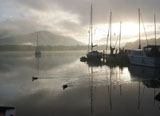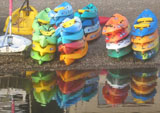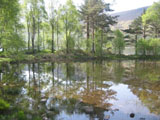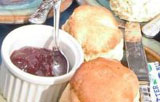|
|
Easy Lake District Valley
and Low-level Walks
Walks around Grasmere & Rydal
Click here for more easy walks around
Grasmere and Rydal
Easedale Tarn, Grasmere
Although Easedale Tarn is isolated in the fells above
Grasmere, it is easy to reach from the village. It is a popular walk for
beginner fell-walkers, with a real feel of being in the mountains. This
route begins in Far Easedale, allowing you to enjoy the peace and quiet
before climbing to Easedale Tarn and encountering the crowds who have
ascended from Grasmere. However, in winter crossing Sourmilk Gill where it
leaves Easedale Tarn is normally impossible, necessitating a circuit of
the lake, in itself almost impractical due to the boggy ground and inlet
streams around its shore. So, a walk best reserved for the spring, summer
or autumn!
Distance and terrain: 7.5km (4.5 miles), including the 1.5km circuit of
the tarn. Straightforward walking for the most part, a steep climb to
Easedale Tarn and some rough ground during the descent.
Parking: Use the
National Park car park in the village, just north of the shops on the
B5287.
Walk along Easedale Road, away from the village centre. Pass the entrance
to the Youth Hostel, and just after the Glenthorne Quaker Centre take the
gate on the left onto the permissive path which takes you off the road. You rejoin the road at Goody Bridge and just past
the farm, the road swings right. The footbridge in the trees on your left
is going to be on the return route, so don't be tempted by the sign to
Easedale Tarn. Continue along the road, past the gateway to Lancrigg Hotel, and the road
takes you across a field, with the sharp pinnacle of Helm Crag directly
ahead of you.
Once past a small cluster of houses (including the engagingly named Little
Parrock), you come to a fork. Go right (signed Far Easedale and Helm
Crag), onto a rough track which leads up to a metal farm gate. Go through
the farm gate (ignoring the sign on your right, which lures you off to the
Wordsworth memorial and the hikers' tea barn) and then bear left to
another fork in the path. Go left, signed Far Easedale and Borrowdale. The
path takes you between some fine examples of dry stone walls and across a
number of fields. It is an easy route to follow. One intriguing point -
who thought to plant a monkey-puzzle tree out here in the middle of
nowhere? (It is by the field entrance, just before you reach two stone
barns on your right.)
This path feels very isolated. When you reach the stone barns, you can
glance across the valley to see the swarm of dots heading up the more
direct route to Easedale tarn.
A few minutes after the barns, you reach Far Easedale Gill, which is a
pleasant, bubbling companion as you follow it upstream. The path brings
you to a long wooden, footbridge. Cross over and you can see the footpath
to Borrowdale winding across the fell ahead of you, disappearing into the
head of the valley. 40m from the bridge, the path forks. Go left and climb
steeply past a split boulder and a footpath marker.
The path climbs to the top of the field on your left, then, at another
pair of marker posts, it veers off to the right. Keep climbing and after
ten minutes or so you come to Sourmilk Gill and another view of the main
path to the tarn. Keeping to your side of the gill follow the path around
the boggy bits. Dogs are very useful here as they tend to rush ahead and
you can tell by the various splashing noises which routes to avoid.
This boggy section gets horribly wet in winter and there are occasional
lines of stepping stones. Not enough, however, so don't hesitate to
abandon the path and climb to firmer ground when you need to. The path is
running roughly parallel to the river, although it is out of view most of
the time, concealed by the bracken. The path finally approaches the gill
and then suddenly you arrive at Easedale Tarn.
The tarn is very pretty, with impressive crags on three sides: from the
left, these are Blea Crag, Slapestone Edge, Tarn Crag and Greathead Crag.
There is usually a seagull perched on the rock in the centre of the tarn.
You could cross the beck and head straight downhill but if it is
relatively dry underfoot, it is worth circling the tarn. Heading
anticlockwise around the tarn, the perspective changes dramatically. As
you reach the far side, the path climbs to avoid boggy sections and you
should work your way up to a major footpath which continues out of
Easedale and on to Stickle Tarn and the Langdales. Once you hit the path,
turn left and follow the route back to Sourmilk Gill. The entire circuit
takes about half an hour.
As you reach the Gill, the path forks. Go right or you could end up
circling the tarn forever. After walking downhill for 20m you have a
tremendous view of Helm Crag and Grasmere, with Fairfield on the far side
of the valley. The route downhill is fairly straightforward, though rough
underfoot in places. After fifteen minutes or so you come to the first of
the cascades in Sourmilk Gill. The rock pools just below are great for a
paddle on a hot summer day.
The path drops down to a stone wall, through a kissing gate and joins a
farm track across the fields. Keep to the track, through an ornate metal
farm gate and across another field. At the far side, over a concrete
bridge, there are two farm gates. Go through the left gate and back
alongside Easedale Beck. The path leads into the woods, takes you across a
footbridge and you are back at Easedale Road by the Lancrigg Hotel. Go
right and seek out one of the tea shops in the village.
Rydal Caves and Rydal Park
4 miles [6.5 km]
This walk gives the best views over Rydal Water and takes you to the
man-made caves of Loughrigg Quarry. Wordsworth enthusiasts can visit Rydal
Mount, the home of the poet for thirty-seven years. The walk has the merit
that, with luck, one can arrive back with reasonably dry footwear.
Park the car on one of the Ambleside car parks. Walk on along main road
towards Grasmere and Keswick. The curious Bridge House is passed. Its
origin is something of a mystery but one theory is that it was built by
someone to avoid paying land rent. Cross over to right hand side of road.
When the pavement ends at a drive entrance cross the road again with great
care. After half a mile the cricket field is on the left, and after this
there is a wood above the road level. At the end of this wood there is a
gate into a field. Go through the gate.
There is no apparent path in the field, but slightly to right of front,
beyond a slight knoll, is a group of trees. Head for the right of these.
There is only a right of way across the field. Continue past the
trees on the same line and the river will be reached and the stepping
stones. Cross these with care to join road at the other side. Turn right.
Go through the gate by the cattle grid and continue along the road to
another gate and cattle grid. Turn left down the lane through another.
Follow this lane until an iron gate is reached which leads onto fell land
and distinct tracks. Take the upper track, and at the seat there is a
perfect view over Rydal Water. The crags across the lake are Nab Scar. The
cottage at the foot was the home of Hartley Coleridge, son of Samuel
Taylor Coleridge and friend of the Wordsworths.
Follow the track up, through woodland. After a bend right a conical crag
will be seen and Loughrigg Quarry has been reached. If you go to the left
of this crag the smallest cave will be seen across a gully. Go back onto
the track and continue up, zig-zagging left then right through some
attractive larch trees. The big cave can then be seen and entered.
The platform of waste opposite the cave entrance is a natural rock garden.
Although there is little soil here, if the land was not grazed by sheep it
would soon be colonised by the larches, silver birch and ash trees which
can all take root in the quarry waste. Where sheep cannot reach seeds will
germinate.
Follow the track back to the view-point scat, then descend towards lake
and a kissing-gate will be seen in the wall on the right. Go through this
into the wood. Follow it to a footbridge. This brings us onto the main
road again. Cross it. Turn right towards Ambleside but go
left up the nearby access road. Rydal Chapel is on the left. Wordsworth
helped to choose the site where
it was built and worshipped here regularly. If it is daffodil season then
go through the chapel yard to Dora's Field beyond, to see a golden
carpet.
Go on up the road. Some old cottages can be seen on the left. Just above
them is Rydal Mount which is now open to the public. Our way from here
is on the right. Just above the entrance drive to Rydal Hall, which is a
conference centre and not open to the public, there is another entrance
onto a lane. Follow this through the yards of the buildings, turning right
at the end after crossing the bridge, then bearing left at the Y junction.
This is Rydal Park. It is the private park of Rydal Hall and there is no
access off the lane but we can enjoy the walk along this pleasant lane
none the less. There are some fine trees and the well cared-for fields can
be an unbelievably bright green. They are the scene of the well known
Rydal Sheep Dog Trials.
The main road is joined again through some tall iron gates. Cross the road
to the pavement on the far side. Continue left to
Ambleside, about a third of a mile.
Grasmere and Loughrigg Terrace
3.5 miles [5.5 km]
Grasmere is Wordsworth country. This walk is
a
classic walk of the Lake District. No lover of Wordsworth can miss it.
Every lover of the Lake District must do it at least once. But it is very popular. Allow two and a
half hours for the walk - but much longer if you want to lounge with a view
across the lake, or linger at Grasmere church, Dove Cottage or the
Wordsworth Museum.
The walk starts at Whitemoss Common. This is a mile south of Grasmere on
the Ambleside road. From Ambleside it is about 2.5 miles along the Keswick
road. Park in the car park on the common. Walk down to the river Rothay
and then walk upstream to the footbridge. Cross it and go directly upwards
into the wood. The track is soon well-defined. At the fork keep upwards,
and at the end of the wood go through the kissing-gate. Beyond is a track
onto open fell. Turn right onto it and climb a steep zigzag. The seat near
the top offers an excellent view back over Rydal Water. The fell here is
owned by the National Trust and there is free public access.
But your walk continues over the brow of the hill. There is a glimpse of
the foot of Grasmere Lake, and there is a view over the river to Pennyrock
wood.
There is a quarry waste heap from an old quarry to the left of the track
as you proceed. If the slate is searched, a piece can usually be found
with a pattern of ripples. Cut and polished, this type of slate is very
decorative. Strike the slates together and they sound almost metallic with
hardness. These two qualities have helped to make the Lake District slate
highly valued all over the world.
As you walk further round along the track a fuller view of the lake is
opened up with a rough-cragged summit of Helm Crag behind. The shape of
the 'Lion and the Lamb' is not too obvious from this point.
The best view of the lake is at the seat just before the track is broken
away by a beck. Close beyond this beck a faint track can be seen
descending to the lake shore. Descend this slowly. A bog near the bottom
can be avoided by turning left just before the
hawthorn tree, to follow another small beck down. The lake shore is
another place to linger before turning left along it to a wall and a
kissing-gate leading into Deerbolts Wood. Turn down to lake shore again
and continue on. You soon leave the wood by a stile. There is now a
permissive footpath continuing by the lake shore shingle. The fields are
farmed and are not open to the general public so you should keep to the
path. Delightful views over the lake and its island open up. The fell on
the right, at the head of the lake and most dominant, is Seat Sandal
(2,365 ft). The path continues over stiles when it ends path turns sharp left to the road above through a stile.
Join the road and turn down right. Watch for traffic and keep well in. Walk right down to the village. At the
first junction on the approach, turn right, and go past the nursery to
join the T junction. Turn right to St Oswald's Church. Enter the
churchyard by the second gate. The Church, the oldest part of which dates
back to the 13th century, is worth a visit. Its alterations over the years
make it an architectural curiosity, but of course it is famous for its
Wordsworth associations. The floor of the church until the 19th century
was earthen, and was strewn with rushes. The rush-bearing ceremony is
still followed by the local children on the Sunday nearest to St Oswald's
day (5th August).
The graveyard is on the eastern side of the church. William Wordsworth and
his wife Mary are buried under a simple stone near the river side. Dora
Quillinan, their daughter, is buried in the next grave. North of these can
be found the grave of Hartley Coleridge, the eldest son of Samual Taylor
Coleridge, the great poet who was Wordsworth's friend of earlier days.
Hartley, himself a writer, lived at Nab Cottage overlooking Rydal Water.
Leaving the church, cross the bridge, and continue on. The field on the
left is the scene of the well-known Grasmere Sports. At the main road
junction cross and go up the lane directly opposite. Dove
Cottage will shortly be seen, standing back a little on the left shortly
after the first buildings. It was the home of Wordsworth in his most
inspired years between 1799 and 1808. Afterwards, for twenty years, it was
the home of Thomas De Quincey. The house is
open to the public on weekdays. The Wordsworth museum is opposite, down the
little lane.
Continue up the road until a duck pond is reached. Turn right along the
road just after this. As this road is ascended another view of Grasmere
opens up on the right. At the top of the road the woodland is left, and
the road is on open fell with a view down to Rydal Water. A better view
can be obtained from the grass bank to the left, but the lake is in view
all the way down to the road to Whitemoss Common, and our starting point.
|
 |



